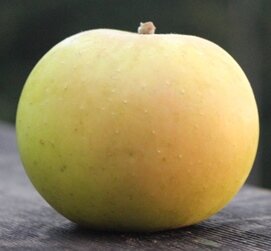Duke of Devonshire
Why you should be excited
Duke of Devonshire is a 19th century English apple that delivers classic strong apple flavours.
The story of Duke of Devonshire
To distinguish folks who just like apples from true apple connoisseurs, ask about russet.
Depending on their knowledge and open-mindedness, an apple-liker might not know what russet is or might consider it – rough brownish sections on an apple’s skin – to be a defect.
A connoisseur, however, will know that russet is a natural occurrence, that some varieties are always covered with it and that it’s anything but a defect.
Duke of Devonshire often shows significant russeting, yet it’s much appreciated for its complex apple flavours and a near-perfect balance between sweet and tart.
Russet’s beauty certainly is in the eye of the beholder.
Duke of Devonshire Facts
Its origins
Seedling raised in Cumbria, England; introduced in 1835.
Flavour, aroma, texture
Firm, fine-textured and fairly juicy, with a rich, nutty flavour. Sweet as well as slightly tart. Best after some time in storage.
Appearance
Medium-sized flattish apples are a golden-green colour, almost always with significant russeting.
When they’re available
Late season (usually in October).
Quality for fresh eating
Very good.
Quality for cooking
Mainly used for fresh eating.
Quality for cider
Not well known as a cider apple, but it can contribute a nice balance of sugar and acid to a cider blend.
Keeping ability
Very good (up to 5 months when kept refrigerated).


